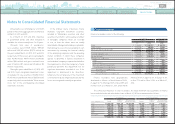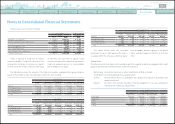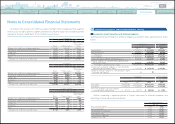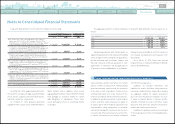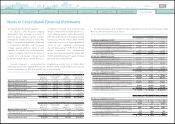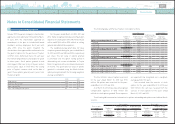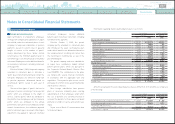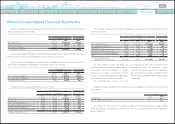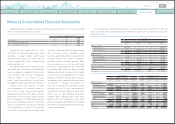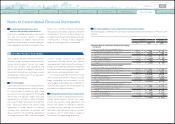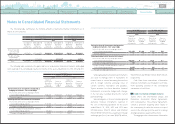Toyota 2012 Annual Report Download - page 99
Download and view the complete annual report
Please find page 99 of the 2012 Toyota annual report below. You can navigate through the pages in the report by either clicking on the pages listed below, or by using the keyword search tool below to find specific information within the annual report.
TOYOTA ANNUAL REPORT 2012
Toyota Global Vision Changes for Making
Ever-Better Cars President
ʼ
s Message Medium- to Long-Term
Growth Initiatives Special Feature Management and
Corporate Information Investor Information
Business and
Performance Review Financial Section
Notes to Consolidated Financial Statements
The factors used to assess the likelihood
of realization of the deferred tax assets are the
future reversal of existing taxable temporary
differences, the future taxable income and
available tax planning strategies that are prudent
and feasible. All available evidence, both positive
and negative, is considered to determine whether,
based on the weight of that evidence, a valuation
allowance is needed for deferred tax assets which
are not more-likely-than-not to be realized.
As of March 31, 2012, the parent company
and its national tax filing group in Japan are in a
cumulative pre-tax loss position in recent years.
Meanwhile, Toyota has concluded that there
is sufficient positive evidence to overcome the
negative evidence of this cumulative pre-tax loss
as operating results from the parent company and
its national tax filing group in Japan recovered in
the second half of this fiscal year as a results of
increased production volume, vehicle unit sales
and cost reduction from the first half of the
fiscal year. Other positive evidence considered
includes future forecasted taxable income in
the fiscal year 2013 and beyond and effective
tax planning strategies, inclusive of sales of
appreciated assets. This forecasted taxable
income is expected to be generated mainly from
an increase in worldwide automotive industry
demand and continuous cost reduction efforts
and is anticipated to be sufficient, over a number
The other amount includes the impact of
consolidation and deconsolidation of certain
entities due to changes in ownership interest
and currency translation adjustments during the
years ended March 31, 2010, 2011 and 2012.
Because management intends to reinvest
undistributed earnings of foreign subsidiaries
to the extent not expected to be remitted in the
The valuation allowance mainly relates to deferred tax assets of operating loss and foreign tax
credit carryforwards for tax purposes that are not expected to be realized. The net changes in the total
valuation allowance for deferred tax assets for the years ended March 31, 2010, 2011 and 2012 consist
of the following:
of years, to realize the deferred tax assets prior
to expiration of operating loss carryforwards in
2021.
If the sufficient taxable income for the fiscal
year 2013 or future years is not achieved due to the
factors which cannot be anticipated such as high
competition and volatility of worldwide automotive
market, steep strengthening of Japanese yen
and increase in prices for raw materials, or if tax
planning strategies are no longer viable, it could
affect the realization of deferred tax assets of the
parent company and its national tax filing group
in Japan.
Operating loss carryforwards for tax purposes
as of March 31, 2012 in Japan and foreign countries
were ¥496,104 million
(
$6,036 million
)
and
¥643,190 million
(
$7,826 million
)
, respectively, and
are available as an offset against future taxable
income. The majority of these carryforwards in
Japan and foreign countries expire in years 2013 to
2021 and expire in years 2013 to 2031, respectively.
Tax credit carryforwards as of March 31, 2012
in Japan and foreign countries were ¥99,423
million
(
$1,210 million
)
and ¥9,003 million
(
$110
million
)
, respectively, and the majority of these
carryforwards in Japan and foreign countries
expire in years 2013 to 2015 and expire in years
2014 to 2023, respectively.
foreseeable future, management has made no
provision for income taxes on those undistributed
earnings aggregating ¥2,690,416 million
(
$32,734
million
)
as of March 31, 2012. Toyota estimates an
additional tax provision of ¥96,320 million
(
$1,172
million
)
would be required if the full amount of
those undistributed earnings were remitted.
Yen in millions
U.S. dollars in millions
For the years ended March 31,
For the year ended
March 31,
2010 2011 2012 2012
Valuation allowance at beginning of year ¥ 208,627 ¥239,269 ¥280,685 $ 3,415
Additions 46,704 55,791 96,754 1,177
Deductions
(
14,066
)(
10,077
)(
65,566
) (
798
)
Other
(
1,996
)(
4,298
)(
2,605
) (
31
)
Valuation allowance at end of year
¥239,269 ¥ 280,685 ¥309,268 $ 3,763
0820
Search NextPrev page 99
Contents


